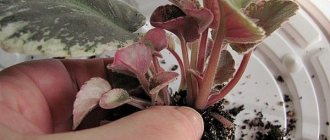Ficus plants do not tolerate transplanting or changing pots well, and even a simple change in the location of the plant in the apartment can cause the ficus to slow down its growth or even shed its leaves. But, despite this, young ficus trees are replanted annually, and adults - once every 2-3 years.
There are general instructions for transplanting a ficus into another pot at home, although certain varieties of indoor plants will have their own nuances. Therefore, we will consider the generally accepted instructions for transplantation and provide recommendations for individual varieties of crops.
When is a transplant needed?
To determine when it is necessary to replant a ficus, you need to monitor the plant. Main signals:
- The roots begin to grow through the drainage hole - there is not enough space for the root system.
- In general, the condition of the leaves and above-ground parts of the plant deteriorates.
- There are problems with the soil - mold appears or pests appear.
- A flower's disease becomes an obvious need to change its place of growth.
Roots have sprouted
Note ! The right time to transplant a ficus is from March to August. But it is better to replant it in the spring.
Principles of growing ficus
Of course, it would probably be much easier to start replanting ficus benjamina or any other species from the very basics: choosing a pot, filling the soil and planting itself. However, everything is not so simple.
Important! Before transplantation, it is necessary to carry out the preparatory stage, otherwise the flower may begin to die immediately after the manipulation.
As for the preparation process, it consists of several nuances.
Namely:
- in choosing and preparing a pot;
- in the purchase or preparation of soil;
- in the correctness of the transplantation manipulation.
How often to replant ficus
How to transplant begonia to a new place
This procedure is perceived by the plant as stress, so it should not be abused. Ficus should change the old place to a new one once every 3-4 years. But there are exceptions when the process of changing the pot is required much more often. In order not to make a mistake with the transplantation regime, you should carefully monitor the plant - it will tell you.
Need for transplant
Rules for selecting and preparing containers
Before you find out how to properly transplant a ficus, you should stop at the pot. It is very important that the diameter of the new container is a couple of centimeters larger than the “native” pot. The same point applies to the height of the container. Only flowerpots with holes at the bottom for aeration and drainage of excess liquid are suitable for planting.
The day before the transplant procedure, disinfection should be carried out with a formaldehyde solution. After this, you can lay a “drainage cushion” on the bottom, consisting of broken bricks or drainage expanded clay. True, there should not be very many of these elements. Ideally, no more than 15% of the total amount of soil. The latter can be purchased at a specialty store or prepared yourself.
How to choose a pot and soil
When to replant gooseberries to a new place
First you need to choose a suitable pot. What to look for when choosing:
- The container should be 4 cm larger in diameter than the root system if the pot is round, or 2 cm larger on each side of the previous perimeter if the shape is square.
- The material of the pot can be anything - ceramics, plastic, clay. But natural material is considered preferable.
- The depth of the container must be selected in accordance with the size of the plant’s root system.
The soil should be like this: leaf soil + turf soil + peat + coarse sand. When preparing the soil mixture, you should adhere to the proportions of 2:2:1:1, respectively.
Pot option
You can use agroperlite instead of sand. The modern component will improve all the qualities of the soil - breathability, balance moisture, and provide additional loosening of the soil.
Soil disinfection
If the substrate will be made independently, then care must be taken to properly prepare each component. To do this, the land is completely disinfected. There are 4 main ways:
- Freeze the soil for 2 weeks at temperatures below -10 °C.
- Calcination in the oven. Place the sheet in the oven for 3 hours at 180°C.
- Rinse the soil with a weak solution of potassium permanganate and then dry the material.
- Rinse the soil with boiling water. You need to do this several times, and then dry the base well.
On a note! You can use ready-made disinfectants to prepare the soil mixture.
Choosing a pot for planting
Plastic or ceramic products are chosen for transplantation. Experienced gardeners advise using plastic containers for ficus. The roots of tropical plants do not tolerate cooling well, and the walls of ceramic vessels can become very cold in winter. For aesthetic appeal, a plastic container with a flower can be placed in any pot suitable for the interior.
Interesting! A beautiful perennial flower is the Perennial Daisy.
Adult forms of rubber-bearing ficus, about 2 meters high, are often grown in wooden barrels with a volume of up to 20 liters. For optimal development of young plants, each subsequent pot is chosen 3 cm wider and the same amount deeper than the previous one. The height and diameter of the pot should be approximately the same, taking into account the need to lay drainage in a layer of up to 1/3 of the container.
Preparing for transplant
When to dig up crocuses - transplant to a new place
Before replanting the ficus, it must be prepared for this procedure. It is necessary to stop watering a few days before transplanting. Then the soil in the old pot will dry out a little, and the plant can be easily removed from the container by collapsing the walls of the pot.
Preparing for transplant
When the plant with the earthen ball is removed, you can begin to prepare the root system. To do this you need:
- Soak the earthen lump in water.
- Inspect the root system for damaged or damaged areas.
- Remove bad roots and sprinkle the sections with activated carbon powder.
What pot is needed for ficus benjamina
Repotting indoor plants begins with selecting a container. A pot that is too loose or too tight is not suitable for Ficus Benjamin:
- After rooting, the cuttings should be planted in plastic cups or containers with a diameter of 10-11 cm. There they will grow until they completely entwine the earthen ball with roots.
- Gradually, the diameter of the container is increased by 2-3, and then 3-4 cm. For an adult flower, you can make a choice by placing the old pot in a new one. It is difficult for your thumb to fit into the gap between the walls.
- An old tall ficus lives in a tub and does not need replanting. Small Benjamin varieties, such as Natasha, will never grow to this size.
Shape and material:
- The container needs to be plastic or unglazed clay.
- It should not be low and wide - this is suitable for Ginseng or bonsai. Benjamin or Rubber will not grow there.
- The ideal shape is regular, classic.
The design of your home may require pots made in a certain style. It is possible to choose ones suitable for any interior, but they are often made from materials not intended for growing flowers. The ficus is planted in a regular container, even in a shipping container, and then they use a beautiful pot as a planter, so there is no need to even look for a compromise here. If it is too deep, it is filled with expanded clay to the required height.
Transplant methods
There are several methods of transplantation, each of which has its own distinctive features. For example, to root a shoot during the propagation period, planting in a ready-made substrate or germination in water is used. The same methods apply when used instead of a shoot cutting.
The ficus transplant itself is carried out as follows:
- A new container is prepared with a drainage layer and a new substrate.
- The plant is prepared in accordance with the above rules.
- A hole is made in the soil for the root system. The shoot is installed and the root is sprinkled with substrate.
- Press the soil in the area of the stem. Provide minimal watering. It is better to use a spray bottle for spraying.
Transfer
Features of the procedure for different types
There are more than 1,000 species in the ficus family, many of which are not alike. Outdoor cultivated hybrids range from creeping vines with small leaves to indoor trees over 2 meters in height. Therefore, the transplantation rules for some of the ficus trees may differ significantly.
Read a useful article: how to care for ficus.
A typical and familiar representative of the family is the rubber-bearing ficus. Using his example, it is easiest to describe the basic rules for transplanting most of his relatives.
Principles of ficus transplantation:
- Young, fast-growing plants with a significant amount of green mass need to replace the pot with a larger one once a year.
- After reaching 5 years of age, transplantation is carried out once every two years.
- With significant growth and weight of plants, it is recommended to do without replanting, only replacing the upper part of the soil with fresh substrate.
When growing a fast-growing ficus, there is a temptation to take a larger pot in order to replant less frequently and give the tree room to develop. This technique can harm the plant. Soil that is not mastered by roots tends to deteriorate, and an increased increase in root mass can inhibit the development of the crown.
Dwarf home forms of ficus are extremely popular. They are decorative in themselves, they are grown in bonsai style or formed into entire sculptures. Ficus Benjamin is a short plant (up to 40 cm), its most popular varieties - Ficus Natasha, Anastasia, Starlight, Kinki - are distinguished by flexible, pliable trunks. This determines the peculiarity of transplanting this variety.
To create wood sculptures, plant branches and trunks are bent, intertwined and secured with wire, tape or adhesive tape. The main thing when transplanting such groups is to try not to damage the fixed trunks and prevent injury to the bark. The rest of the procedure follows the general rules.
Another popular type has noticeable differences. Ficus Microcarpa is grown as a bonsai. The microtree develops very slowly, and in adulthood it practically stops growing. This property is especially valued in the art of bonsai and there is no need to stimulate the development of the plant. Replanting such a crop is only needed to renew the soil.
You can use the same pot after washing and disinfecting it. An adult ficus bonsai is not replanted, but only the top layer of soil is replaced with fresh one.
Care after replanting a plant
Regardless of what type of ficus was transplanted, it must be properly cared for, otherwise the plant will die.
Additional Information ! After transplantation, there may be a cessation in the growth of the above-ground part and partial loss of leaves.
Principles of caring for ficus after the procedure:
- Temporarily stop fertilizing, as the new soil is quite fertile.
- In the first month, reduce watering to once a week, but at the same time spray the crown daily.
- Place the flowerpot in a slightly shaded place so that the flower adapts to new conditions.
Why is this necessary?
If the ficus is not replanted in time, it will slow down its growth, the leaves will turn yellow and crumble. The lump of earth will begin to dry out quickly and with frequent watering, you can flood the plant. This leads to rotting of the roots and disease of the entire flower.
A weakened plant is unable to fight diseases and indoor pests. Therefore, at the first sign that the pot has become small, urgently start replanting the flower.
During this procedure, all roots growing upward are removed after they have reached the bottom of the pot. This procedure is not often done once every 5 years. It rejuvenates the root system, making it powerful and healthy.
This plant is clearly craving a transplant into a larger pot.
There is an immutable rule for removing roots. Only 1/3 of the part is removed, but no more. Otherwise, the large-leaved beauty will get sick and be stunted.
It is important to know! Be sure to take a pot with a hole, or even more than one. Water should flow through them into the pan. Otherwise, if watered incorrectly, the roots will rot and the pet will die.
How to transplant a ficus at home without mistakes
To minimize the number of errors when replanting a ficus, you need to:
- Select the correct primer based on the composition of its components.
- Choose a good and correct pot.
- Lay a drainage layer.
- Choose the right time for the transplant.
On a note! A common mistake made by inexperienced gardeners is improper preparation of the plant or excessive pruning of the root system.
You should never replant a ficus in winter, as this can destroy the plant. The remaining options for the procedure are acceptable for the plant. The main thing is to choose the right container and substrate.
Beginner mistakes
When transplanting, flower growers sometimes make mistakes that can affect the growth and development of ficus. The main ones:
- Recommendations regarding soil composition, consistency, and acidity are not followed. These needs are determined by the wild environment in which the plant grows. Therefore, if you could not find the necessary components to make up the substrate, it is better to buy a ready-made mixture;
- no drainage layer has been made. Under such conditions, the root rots - ficuses cannot tolerate excess water;
- wrong pot size. In a pot that is too large, the soil will turn sour, as indicated by an unpleasant odor. This harms the plant, dwarf varieties;
- watering with fertilizers immediately after transplanting. During this period, the root system is not able to accept nutrients in such quantities. What is in the new soil is enough;
- Frequently moving the flowerpot injures the plant. After transplantation, it is better to leave it in its original place if it felt good there. Ficus plants should not be placed in an environment that is very different from the previous one.
Why does the ficus shed its leaves after transplantation?
Ficus plants sometimes drop a small number of leaves after replanting. This is natural because the plant is under stress. It is especially difficult for him if the root system is damaged. Recovery may take 1.5–2 months. It is advisable not to over-water and not to use fertilizers at this time.
It is undesirable to replant indoor ficus in the fall, and even more so in winter, when its vital processes are slow and growth stops. In March or late February, the plant “wakes up” and tolerates moving into fresh, fertile soil with great enthusiasm. If the place where the ficus stands is sunny, and the soil is loose, with good drainage, new leaves quickly appear and shoots begin to grow.
If you plant Ficus Benjamin in a pot that is much larger in volume than its root system, problems may begin a few months after transplantation. Moisture from the substrate surrounding the roots will not be absorbed as necessary, and the process of rotting will begin.
The quality of the soil in which the plant is planted also plays an important role. It is undesirable for it to be simple peat, which absorbs moisture and retains it for a long time. The soil should be loose and allow water and air to pass through well. You can buy special soil for ficuses, and put a drainage layer of about 3 cm at the bottom of the planting container.
Is it possible to transplant a ficus in winter?
It is better to replant ficus in March. Even if it does not remain dormant in winter, biological processes slow down due to a lack of light. With the onset of spring, all life processes become more active. Therefore, changing the potty is better tolerated.
In autumn, transplantation is carried out more often for unforeseen reasons:
- there was rapid growth over the summer;
- the soil became very compacted and needed to be replaced;
- dishes were damaged, etc.
If the transplant is carried out in early autumn, then the ficus will be able to recover before the arrival of winter.
Ficus transplantation should not be done in winter unless there are emergency reasons. In winter, all types of ficus have a dormant period.
As you know, it is highly not recommended to disturb a plant during its dormant period, that is, recuperation, especially to carry out such serious procedures as replanting, pruning, and others. During the dormant period in winter, the ficus needs to be cared for based on weather and climatic conditions: place it not near heating devices, maintain the usual room lighting and air humidification. Over the winter, the ficus will have time to gain strength, so that the spring planned replanting will be tolerated easily and without significant health consequences that can arise if the plant is disturbed in winter.
Diseases and pests
Ficus elastica Melanie is susceptible to infection with thrips, spider mites and scale insects.
To combat them, you need to wash the leaves of the plant with a damp sponge and a weak soap solution, and then treat them with chemicals.
In addition, the plant may experience the following problems associated with improper maintenance conditions:
- the leaves droop - the room is hot, the air is dry. It is necessary to spray the flower regularly;
- shedding of leaves - this may be due to two reasons: low air temperature or incorrect watering regime.
In the first case , you need to move the pot to a warmer place and remove it from a draft.
Secondly , normalize watering. It is worth checking the condition of the soil and root system; replanting may be necessary to remove rotten roots.
Brown spots on the leaves are burns from direct rays. It is necessary to create shade during the daytime.
Ficus elastica Melanie is one of the popular types of ficus.
It grows as a bush, and therefore provides a great opportunity for experimenting with the crown.
The plant does not require any special conditions, and therefore it can be recommended to those who are just starting to grow indoor flowers.
Ficus will help create comfort and a special original atmosphere in your home or office. On our website we have also prepared for you articles about growing the following types of plants: Tineke, Abidjan, Belize, Black Prince and Robusta.
Possible mistakes of the grower during transplantation
Ficus transplant: video
If you do everything according to the rules, the ficus will delight you with a lush green crown and decorate your home with its presence. Possessing a large green mass, these plants actively enrich the air with oxygen and cleanse it of harmful impurities. Signs say that a well-groomed ficus in the house will bring prosperity, prosperity and comfort to its owners.
Ficuses are unpretentious and grow quickly, so they have to be replanted every two to three years. In order for a green pet to feel good and please the eye with bright, glossy greenery, you will need soil suitable for this plant.
Origin of the plant
Ficus rubber grows in tropical Asia from India to Indonesia.
In nature, these are large tall trees with aerial roots, 30-40 meters high.
Ficus elastica Melanie is the most compact type of rubber-bearing ficus.
It was found in a greenhouse in one of the cities of Holland and is a mutation from another type of ficus elastica - Decor.
From the cuttings taken from him, new plants were grown that completely retained the properties of their ancestor, which made it possible to distinguish Melanie into a new variety.
ATTENTION! The main feature of this flower is that it grows not in height, like a tree, but laterally, like a compact bush. This makes it possible to experiment with its crown while maintaining a small occupied size.
Video about the ficus variety “Melanie”:
How does pruning happen?
Ficus elastica Robusta needs to be pruned from time to time to form a crown. This procedure also allows you to restrain the growth of the plant when there is no need for the flower to turn into a huge bush, and then a tree. You can trim as the gardener wants. If there is a desire for Robusta to grow to the sides, then pinch out the top shoots. Most often, 5-6 internodes are trimmed. If you want the plant to grow upward, then do the same with the side shoots.
Manipulation is carried out only in early spring, when the growing season has not yet begun. The branches should be trimmed exclusively with a sharp knife, disinfected in advance, which will prevent infection from entering the “wound” of the plant. After trimming, the cut areas are rubbed with charcoal.
Some gardeners are a little cunning, thanks to which they manage to get a fairly lush crown of the ficus. The fact is that several specimens are planted in one flowerpot at once, the pot is placed in a shaded (but not dark) place, and then the container with the ficus is rotated around its axis. Each plant wants to outstrip its “neighbor” in growth, so it reaches for the light and produces more and more new leaf blades.
It is important
It is not recommended to transfer the plant to a new pot every year if it feels great in the old container. The need for replanting is signaled by roots that peek out of the drainage holes or rise above the surface of the ground. Also, the need to replace the soil is indicated by a stop in growth. In this case, you need to make sure that the ficus has stopped growing not due to disease or pest attacks.
It is not recommended to try to transplant an adult plant alone. Transferring a ficus into a new tub without damaging its roots is much easier with two people. During transplantation, the plant should not be shaken. It must be remembered that it has very fragile shoots and petioles. Any careless movement may cause them to break.
Step-by-step instructions for replanting a plant
First, you need to clean and disinfect all instruments and utensils that will be used in the transplant procedure. The process consists of the following stages:
- 1–2 hours before transplanting, moisten the soil under the tree or bush abundantly. This makes it easier to remove from the container.
- Expanded clay or analogues are placed on the bottom, then sand. Under the drainage, at the bottom, you can put a ceramic shard - the convex part is directed upward. This prevents soil from being washed away.
- A little prepared soil is placed on top of the drainage layer.
- The plant is pulled out of the pot and freed from the old soil, being careful not to damage the roots.
- Examine underground organs. The areas affected by rot are cut off and sprinkled with crushed charcoal.
- The ficus is placed in the center of the pot.
- Fill the pot with substrate. The basal neck is not closed.
- The soil is compacted a little.
- Water with settled water at a temperature of about 25 ° C, drain the excess from the pan after a few minutes.
The transplanted plant is placed in its original place. The next time the soil is moistened, when the earthen lump on top dries out. Small plants can be covered with polyethylene, creating greenhouse conditions. The film is removed 1-2 times a day to ventilate the seedling.
If it is necessary to transfer, for example, when seedlings are moved to a larger pot, a lump of old soil is left on the roots. Then, after moving it to a new pot, add the missing amount of soil.
After transplantation, the ficus needs special care and conditions:
- temperature 20–25 °C;
- watering only after the top layer of soil has dried;
- daily spraying of shoots with warm water.
Fertilizer is applied only a month after transplantation at intervals of once every 15 days.
Main problems
Beginning gardeners may encounter problems such as leaf drop and yellowing. Most often this is due to the fact that the ficus is in a draft and is constantly damaged by cold air. It is also worth checking the soil, which may be too dry.
With a lack of nutrients in the soil, the leaves of the plant begin to become smaller and do not grow to a normal plant. Large leaves are shed.
Among the indoor flowers in my house there is a ficus Elastica. I bought it for my home quite a while ago.
This type of ficus is unpretentious in care; it will not be difficult to look after it even for the least enthusiastic lover of indoor flowers. But still, even with such a seemingly problem-free plant as ficus Elastica, it is worth paying attention to some points regarding its care.
I cannot classify myself as a professional flower grower; after all, I am an amateur. Therefore, in the process of leaving, I made mistakes that I would like to protect readers from.
What soil is suitable for replanting ficus
Many people don’t rack their brains, but simply buy ready-made soil in the store. You should not do this, because the bag often contains lowland peat with a large number of unnecessary impurities. After all, even ordinary sand strongly cements the soil, which has a bad effect on breathability and prevents water from being absorbed during irrigation.
A little effort, a little searching, and you can independently collect the soil mixture for replanting the ficus. All you need is:
- turf land
- fine gravel
- rich garden soil
- well-rotted manure or compost
- high peat
All this goodness is taken in equal quantities, then mixed thoroughly. Now you need to disinfect the mixture and you can safely replant it. Ficus plants of all varieties will like this soil.
Advice. Do not take turf or dirt from roads, highways or highways. Everyone understands perfectly well that there is a huge amount of harmful substances there. Don’t be lazy to go to the forest or park.
Reproduction
It occurs by cuttings, which are cut in the spring 10-15 centimeters long from the top or by fragments of the trunk with 2-3 leaves.
After cutting, you need to place it in a glass of water for a while to drain the milky juice.
You can root the cutting by sticking it into the substrate, or by placing it in a glass of water.
In the first case, the pot must be covered with film to create favorable conditions. You can also dip the bottom tip in a root growth stimulator.
Temperature
The best temperature for keeping ficus elastica Melanie is +18-25 degrees.
If the plant is in warmer air, then the leaves must be periodically sprayed with settled water, treated with a damp sponge, or bathed in the shower.
In winter, the best temperature will be +16-18 degrees.
It is undesirable to allow it to fall below +12 degrees , because the root system may freeze, and the plant will shed its leaves in response to this.











